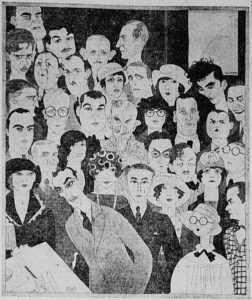We are badly in need of caricaturists. Nowadays, it seems as if the only person who ever gets caricatured is the president of the United States. But, in a society as fame-obsessed as our own, a few more caricatures might be a healthy thing.

Ralph Barton’s group caricature of the contributors to Harpers Bazaar, 1922.
But what is a caricature anyway? Does it just poke fun at a person’s physiognomy? Or is it supposed to reveal character as well? Are caricatures always funny? Are they art?
These are the questions addressed and answered in a New York Public Library exhibit that recaptures the golden age of American caricature—the 1920s and 1930s, when New York cafe society flourished and caricatures were eagerly published by The New Yorker and Vanity Fair.
The show features more than 200 works by such artists as Ralph Barton, Al Frueh, Miguel Covarrubias, Will Cotton, Al Hirschfeld, Paolo Garretto, William Auerback-Levy, and Peggy Bacon. In addition to the portraits, the exhibit reproduces a corner of Sardi’s restaurant, decorated with 24 original autographed caricatures of Broadway stars by Alex Gard. Also displayed is a reproduction of a theater curtain, which delighted audiences in 1922 with 137 hand-painted Barton caricatures of New York’s “first-nighters,” the fashionable folk who regularly attended show openings.
Caricature has been around for centuries but it took on a new form in America after World War I. Fascinated by an emerging celebrity culture, the new caricaturists were less interested than their predecessors in probing for inner corruption.
“It is not the caricaturist’s business to be penetrating,” said Ralph Barton. “It is his job to put down the figure a man cuts before his fellows in his attempt to conceal the writhings of his soul.”
It’s an interesting distinction. Not the inner man, but the persona. Why try to look behind the mask, when the mask is the interesting thing?
This whole fame thing was still new at the time, and people were fascinated with how it worked. Up until a decade or so before, only politicians, generals, or clergymen were public figures. Now, the field was open to baseball players, striptease artists, aviators, crooners or anyone else whose personalities could hold the public’s interest.
Modernism played a part in the new caricatures as well, with early contributions by Toulouse-Lautrec and the French poster artists who followed him. Mexican-born artist Marius de Zayas brought the style to the United States with his Parisian-style inked figures, such as “Consuelo, Duchess of Marlborough,” which brings new meaning to the expression “big hair.”
But Zayas also brought an air of mystery to dark symbolist-style portraits that attracted the attention of photographer Alfred Stieglitz. He believed caricature had as much claim to be art as photography and gave Zayas several shows at his famous gallery at 291 Fifth Ave. The caricature artists began to adopt more conventions from European modernists, elongating, geometricizing, and fragmenting forms, just as the expressionists, the cubists, and the constructivists did.
An almost continuous hallmark of caricature art has been the quick, sinuous line that was first brought to perfection by artist Al Frueh, whose work was also shown by Stieglitz. His caricature of George M. Cohan captures with a few swift lines the performer’s loose, straw-hat-and-cane strut.
But it was the enormously gifted Barton who took caricature to new heights, and created the vogue that inspired Vanity Fair and The New Yorker to pick up on it. He did it with the theater curtain of the “first-nighters,” which is seen here in reproduction, the original having been lost. Barton had done a similar composition on a small scale – a two-page spread for Vanity Fair captioned “A Typical First Night Audience in New York: The Scene Which Invariably Confronts the Actor.” It had recognizable caricatures of 89 figures. The curtain had 139 faces and was dropped without notice during intermission at the Century Roof theater. The audience swarmed up and spent the intermission identifying faces – hoping to find their own.
That was the thing about the era. People wanted to be caricatured. It was a sign of having arrived. When Miguel Covarrubias drew etiquette queen Emily Post taking tea with her bare feet propped on the table and the lurid Police Gazette dangling from one hand, some friends were shocked. But Post, writing to Vanity Fair, said it was “too giggle-making for words” and thanked the magazine for the “delicious publicity.”
Barton’s caricatures often had an edginess to them and a self-mocking irony. His friend, the Hungarian-born photographer Nicholas Murray, was also in the business of making likenesses of celebrities, and Barton drew him as a predator. The caricature has him in the act of snapping a picture, a tensely crouching figure with wild, spiky hair and huge, hawkish eyes, his enlarged hand gripping a pink shutter bulb that looks like a human heart. As Reaves writes, Barton brought to his art “a vague menace that suggested the unhealthy anxiety of celebrity overexposure.”
Barton was incredibly prolific. He once said that he had gone through so many figures in “La Vie New Yorkaise” that he had to wait for more to be born. But, he was no stranger to those “writhings of the soul” he saw behind the celebrity masks. Manic outbursts of creativity alternated with bouts of depression, and he was a suicide at age 39.
The caricature craze didn’t survive World War II. Fashions changed. Magazine editors began to prefer photographs. One thing that didn’t change was the cult of celebrities. It has grown steadily. Where are those caricaturists when we need them?
New York Public Library
2001

